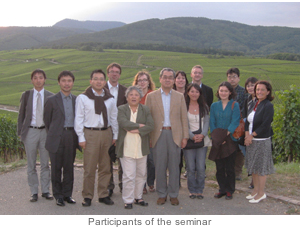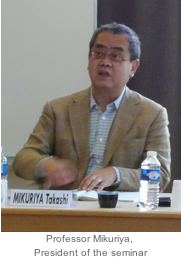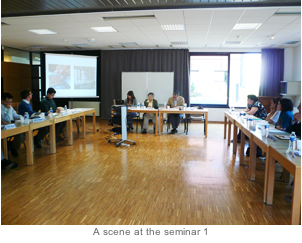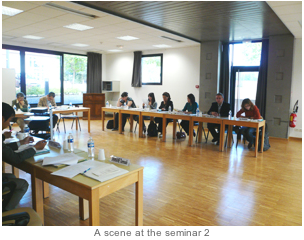Activity Reports:Japanese Studies and Intellectual Exchange:Report on the Japan-Europe Intellectual Exchanges in Alsace "Japanese Studies Seminar on Meiji"
Tomoaki Shimane
Europe, Middle East and Africa Section
Japanese Studies and Intellectual Exchange Department
On September 11 and 12, 2009, The Japan Foundation and Centre Europeen d'Etudes Japonaises d'Alsace (CEEJA) co-organized the seminar described in the title of this article at CEEJA in Kientzheim which is located in Alsace region in France adjacent to Germany.
- Overview
Designed around a broad theme, this seminar for Japanese Studies brings together young researchers on the theme in one place to present their respective works, to discuss and share their opinions with specialists invited from Japan. In doing so, this seminar aims to create in Europe an interdisciplinary network of researchers, with the hope of contributing to advancement of the studies conducted by each scholar.
Following the first two editions that were devoted to "Edo", this year's seminar took the theme of "Meiji". It was chaired by Professor Takashi Mikuriya of the University of Tokyo, who is a scholar of Japanese political history from Meiji to present and the author of books including "Meiji kokka no kansei: 1890-1905 (A history of modern Japan)".
The building of CEEJA was formerly used as the student dormitory of Seijo Gakuen High School in Alsace, which is surrounded by vineyards on three sides, a place of scenic beauty where the mountain range in Alsace can be enjoyed. Participants spent days together in the renovated building and engaged in lively discussions.

- Presentations
 Following the inauguration speeches by Sakae Murakami-Giroux, the vice-president of CEEJA and professor of University of Strasbourg, and Atsushi Oshima, the vice-director of the Japan Cultural Institute in Paris (Maison de la Culture du Japon a Paris), Professor Mikuriya, the president of the seminar, gave a keynote address.
Following the inauguration speeches by Sakae Murakami-Giroux, the vice-president of CEEJA and professor of University of Strasbourg, and Atsushi Oshima, the vice-director of the Japan Cultural Institute in Paris (Maison de la Culture du Japon a Paris), Professor Mikuriya, the president of the seminar, gave a keynote address.
More than 70 years had already passed since 1931 when a poet made a haiku stating 'long ago / Meiji slipped into the past.' Today, most researches in Japan focus on the present, and researches on Meiji era seem to be out of vogue. In addition, researches that will not lead to any economical value, i.e. money-making, are discarded as practically useless. Humanities and social science, including Japanese studies, tend to be underestimated as studies that can be done if you have spare time and money. Such attitude is a serious threat to these studies. Studies on Meiji era, for example, may seem to be self-contained, but it provides valuable perspectives to understand the present situation with deeper insights. Many people in the media have asked my opinion since the power shift occurred at the election in Japan at the end of August. While other intellectuals made comments only from the contemporary viewpoints, I could find many instances to refer in the past because my field of research spans from Meiji era to today. Studies of Meiji era may not provide direct solutions to the current issues, but each of your studies of the era will enhance our understandings of the contemporary society. I do have great hopes of you.
Presentations of the participants are as follows (in the order of appearance):
Nobuaki Takase / School of Oriental and African Studies (SOAS), University of London, UK
"The Meiji state described by Mutsu Munemitsu: Mutsu's research on European political systems and their introduction to Japan"
This presentation made a thorough research on the European political system study made by Mutsu Munemitsu when he was studying in Europe, revieweing how he intended to introduce the system to Japan. This study revealed Mutsu's unknown role as the designer of the state in Meiji.
Martin Norderborg / University of Gothenburg, Sweden
"Resistance against the Westernization of Japan in the 19th century or how a standard American text became a reader of Japanese primary school"
This presentation compared the original text of American schoolbook 'Willson Reader' with the Japanese version of 'Primary School Textbook' translated by the Ministry of Education, Science and Culture immediately after this educational system was promulgated. It revealed how the Meiji government intended to balance modernization and preservation of traditions by converting Christian value into Confucian value.
Atsushi Yamanashi / School of Advanced Studies in Social Science, France
"The turning point of the Catholic Church in Japan in the early 20th century: relations between Japanese Catholics and French missionaries"
This presentation reviewed the relationship between Missions Etrangeres de Paris that played an exclusive role in Catholic missionary work in the modern Japan and Japanese Catholics (such as Chota Maeda) who had awareness of the firsts-class citizen immediately before the outbreak of the Russo-Japanese War at the begining of the 20th century. It well described the characteristics of Catholic churches in the Meiji era.
Anita Lestyan / University of Budapest, Hungary
"The separation of kami and Buddha during the Meiji Restoration"
This presentation first outlined the historical background of amalgamation of Shinto and Buddhism in Japan and then described the Meiji government's policty to separate these two religions and the anti-Buddhist movement that occurred as a result of the separation policy. It reviewed the impact of the separation policy on specific instances, such as Gion-Matsuri, as well as on ordinary Japanese people's minds. It revealed the cause of vague religious concept of Japanese people that is neither Shinto nor Buddhism.

Tomomi Ota / Research Center on the Civilizations of East Asia, University of Strasbourg, France
"Representations of family in the writings of Kafu: fictitious Japanese family and ideal Western family"
This presentation analyzed the comparison between fictitious Japanese family and ideal Western family described in Nagai Kafu's novels published around 1910 and the change of ideal image of Western family. It revealed how Kafu illustrated love, marriage, and family in his novels.
Frederic Ebrard / University of Haute-Alsace, Mulhouse/CEEJA, France
"The novels serialized in the first daily newspapers"
This presentation focused on the novels serialized in the daily newspapers in their early days in Meiji era. It described how these novels were influenced by picture magazines in the Edo era and French political novels, the sales campaigns by big and small newspaper companies, and the collaboration of novelists and illustrators in response to the reaction from the readers.
Silvana De Maio / University of Naples "L'Orientale", Italy
"The fleet of the navy of the Kingdom of Italy and Japan at the beginning of the Meiji era"
Based on the records of "Rivista Marittima (Maritime Magazine)", this presentation revealed the encounter between Italy and Japan in the early Meiji era by reviewing incidents in Japan caused by the navy of the Kingdom of Italy that was in its early days following the great powers such as England and France.

Mariko Akutsu / Lyon University 3, France
"European influence on the production of Imari porcelain in the second half of the 19th century"
This presentation revealed how Imari porcelain producers acknowledged the high quality of European porcelains through several international exhibitions in Europe and achieved the modernization of production by investigating and introducing the machineries. It reviewed the introduced techniques and the policies and the rise and fall of Imari porcelain production companies with specific examples.
Olga Makarova / Russian University for the Humanities, Moscow, Russia
"The Conception of 'Japanese Art' in Meiji Japan"
This presentation described the concept of 'Japanese Art' in Japan that became the nation state in Meiji era for the first time in its history by comparing Fenollosa who regarded Japanese Art as "the idea" of world art with Tenshin Okakura who regarded it as "the museum" of Asian cultures, while both of them relied on Hegelianism.
- Comments
Professor Mikuriya, the president of the seminar, and other participants gave questions and comments to each presentation.
When asked what made them to pursue their caeer in Japanese Studies in Europe, the participants answered as follows : they wanted to challenge European scholars who neglect documents released in Japanese although they are in the field of Japanese Studies ; they were first interested in the regional studies where they went to study and then their interest shifted to the region's perspective on Japan ; they became more interested in Japan when they came to Japan to study ; or they were interested in Japanese society in the past that was described by their fellow countrymen at that time.
At the closing, Professor Mikuriya concluded as follows :
These nine presentations addressed a wide range of themes and each of them was far more productive than I have expected. It must have been quite challenging for them to make presentations in Japanese that was not their mother language. Their researches had unique points of views because they were studying in Europe, not in Japan, although some of them were Japanese scholars. Unfortunately, however, I heard that each individual scholar is rather isolated. I hope this seminar is a springboard to deepen their researches as well as an opportunity to widen their network among fellow scholars.
The report of this seminar will be published in the future.
Related Articles
Back Issues
- 2024.3. 4 Movie Theaters aroun…
- 2023.4.10 The 49th Japan Found…
- 2023.3.28 JF's Initiatives for…
- 2023.1.27 Living Together with…
- 2022.11.16 Inner Diversity <…
- 2022.6.21 The 48th Japan Found…
- 2022.3.22 JF's Initiatives for…
- 2022.3.14 JF's Initiatives for…
- 2022.2.14 JF's Initiatives for…
- 2022.2. 4 JF's Initiatives for…

